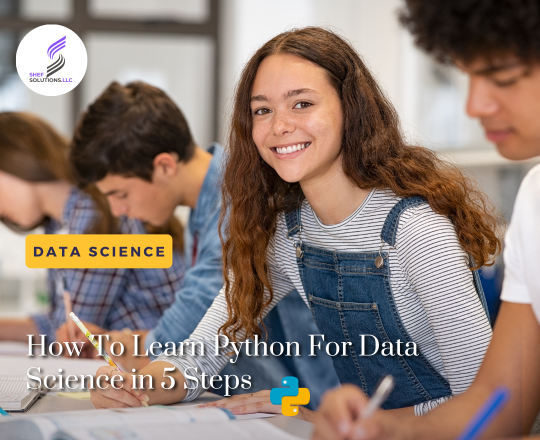Currently Empty: $0.00
Data Science
How To Learn Python For Data Science in 5 Steps

Learning Python for data science is advantageous due to its simplicity, versatility, and extensive libraries like NumPy, Pandas, and Matplotlib. Python’s readability makes code understandable, easing data manipulation and analysis. Its broad community support fosters rapid learning and problem-solving, making it an ideal language for data-driven tasks.
What does the current labor market look like for data scientists?
The labor market for data scientists remains highly favorable, with increasing demand across industries for professionals skilled in data analysis, machine learning, and statistical modeling. Companies are actively seeking data scientists to extract insights from large datasets, drive informed decision-making, and develop predictive analytics solutions.
How To Learn Python for Data Science
Step 1:Learn Python Fundamental
Mastering Python fundamentals is essential for aspiring data scientists. Start by grasping basic syntax, data types, control structures, and functions. Progress to advanced topics like object-oriented programming, file handling, and libraries such as NumPy and Pandas. Solid Python skills form the foundation for effective data manipulation and analysis.
Step 2:Practice With hand on hand learning
Apply Python fundamentals through hands-on practice. Dive into real-world projects, coding challenges, and datasets. Experiment with data manipulation, visualization, and analysis tasks to reinforce your skills. Engage in coding exercises, online tutorials, and collaborative projects to strengthen your Python proficiency.
Continuous practice enhances problem-solving abilities and prepares you for real-world data science challenges. Explore diverse datasets to gain insights into different domains and refine your ability to extract valuable information from data. Hands-on learning solidifies your understanding and empowers you to tackle complex data science projects with confidence.
Step 3 : Learn Python data Science libraries
The four most important python libraries are Numpy Pandas matplotlib
Numpy — A library that makes a variety of mathematical and statistical operations easier; it is also the basis for many features of the pandas library.
pandas — A Python library created specifically to facilitate working with data. This is the bread and butter of a lot of Python data science work.
Matplotlib — A visualization library that makes it quick and easy to generate charts from your data.
Numpy and Pandas are great for exploring and playing with data matplotlib is a data visualization library that makes graph as you ‘d find excel sheet in Excel or google sheet
Step 4 : Build a Data Science Portfolio
As you learn Python, concurrently build a data science portfolio comprising diverse projects demonstrating your proficiency in data manipulation, analysis, visualization, and machine learning using libraries like NumPy, Pandas, Matplotlib, . This portfolio serves as tangible evidence of your skills and enhances your credibility in the data science field.
Present your portfolio effectively
Effectively present your data science portfolio by organizing it in a visually appealing and easily navigable format. Highlight key projects, showcasing your proficiency in Python, data manipulation, analysis, visualization, and machine learning. Provide concise descriptions of each project, detailing the problem tackled, methodologies used, and insights gained. Include links to relevant code repositories or interactive demos to allow potential employers or collaborators to explore your work further.
Tailor your portfolio to reflect your strengths and interests, demonstrating your ability to tackle diverse data science challenges with creativity and skill.
Step 5:Apply advance data Science Techniques
Advance your data science skills by applying advanced techniques such as deep learning, natural language processing, and time series analysis. Utilize Python libraries like TensorFlow, PyTorch, NLTK, and Statsmodels to explore complex data sets and solve challenging problems in diverse domains. Continuously expand your knowledge and expertise to stay abreast of the latest developments in the field and enhance your ability to tackle sophisticated data science projects.
Helpful Python Learning Tips for Beginners:
Start with fundamentals: Begin by mastering basic concepts like variables, data types, and control structures to establish a strong foundation.
Practice regularly: Consistent practice is key to learning Python effectively. Work on coding exercises, small projects, and challenges to reinforce your understanding.
Utilize online resources: Take advantage of online tutorials, documentation, and forums like Stack Overflow to seek guidance and clarification on difficult topics.
Collaborate with others: Join Python communities, participate in coding meetups, and engage in collaborative projects to learn from others and stay motivated.
Build projects: Apply your Python skills by working on real-world projects that interest you. This hands-on approach helps solidify concepts and showcases your abilities.
Read code: Study and analyze code written by experienced Python developers to gain insights into best practices, coding style, and problem-solving techniques.
Seek feedback: Don’t hesitate to seek feedback on your code from peers or mentors. Constructive criticism can help you improve and grow as a Python programmer.
Stay curious: Explore different Python libraries, tools, and applications to broaden your knowledge and discover new ways to leverage Python in various domains.
Be patient and persistent: Learning Python takes time and effort. Stay patient, persevere through challenges, and celebrate your progress along the way.
By following these tips, beginners can accelerate their learning journey and become proficient Python programmers .Page
Conclusion
Master Python for data science in 5 steps: grasp basics, explore libraries, delve into analysis techniques, learn machine learning, and practice extensively. Continuous learning and application are essential. With dedication and practice, you’ll excel in data science, unlocking numerous opportunities in this dynamic field.




